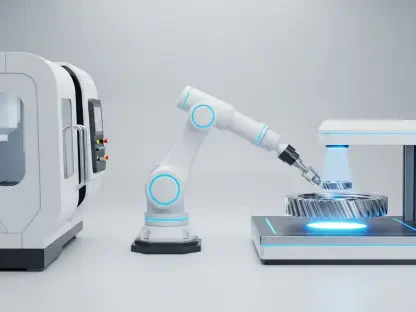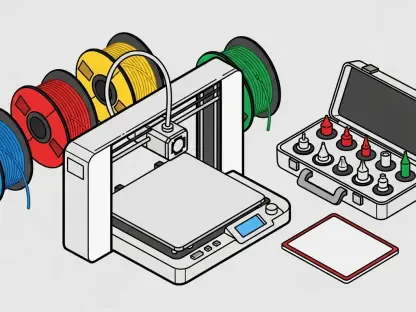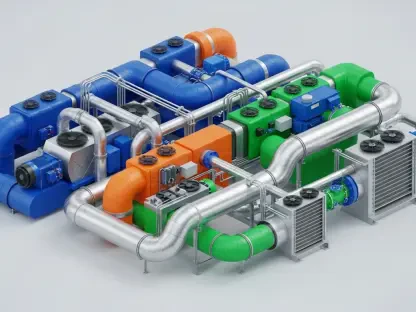The concept of smart factories has emerged as a transformative force within Japan’s manufacturing industry, driven by the integration of advanced technologies with traditional industrial processes. With a focus on automating operations, improving efficiency, and enhancing product quality, smart factories represent an evolution in the way production facilities operate. This progression is both inspired by technological innovations and necessitated by competitive market demands. In Japan, these smart factory initiatives have been met with varied levels of engagement, with only a small percentage of companies actively pursuing this path toward automation. However, the challenges in adopting these new methodologies are significant, including redefining processes and management commitment, as well as effectively leveraging tools like digital twins.
Progress in Smart Factory Initiatives
Technological Innovations and Strategic Goals
Japan’s smart factories are rooted in the technological paradigm introduced by Industry 4.0, which originated in Germany. This movement focuses on the integration of digital technologies such as the Internet of Things (IoT), artificial intelligence (AI), and robotics. The initial aim was to achieve visualization, optimization, and automation within manufacturing sites, but the scope has since expanded to include the entire supply chain and engineering processes. These transformations are intended to create a more interconnected manufacturing ecosystem that enhances efficiency and productivity while maintaining high product quality.
To implement these technological advancements, the Ministry of Economy, Trade, and Industry (METI) in Japan established a comprehensive roadmap. Despite these efforts, only a minority of companies have fully embraced the shift toward smart factories. The key challenge lies in reimagining traditional processes, which often leads to high automation costs and limited return on investment (ROI). Many companies struggle to integrate digital technologies successfully, highlighting the necessity for a clear strategic vision and comprehensive adoption strategies that align technological potential with business objectives.
Organizational Challenges and Process Redefinition
Smart factory implementations often require fundamental changes in organizational structures and processes. One of the main hurdles is redefining existing processes to fully utilize digital strategies and tools such as digital twins. These assets enable the simulation of real-world manufacturing processes, facilitating improvements and optimizations without significant physical investments. However, realizing their potential hinges on the organizational commitment to invest in cross-departmental cooperation. This entails a transformation from siloed departmental projects to a cohesive enterprise-wide initiative.
Managing these transitions effectively necessitates strong executive leadership and support. The lack of management commitment and resources can form a barrier to successful smart factory operations. As these technologies necessitate significant upfront investment and the reskilling of personnel, companies need to maintain a long-term view to justify these expenditures. Companies that have successfully integrated smart factory technologies typically demonstrate robust leadership that aligns efforts across the enterprise. They foster an environment where technological efforts are seen as a critical business strategy rather than an ancillary project.
Current Challenges for Japanese Manufacturers
Resource Allocation and Management Commitment
The commitment of management and the allocation of resources are essential factors in the successful implementation of smart factory initiatives in Japan. Insufficient management support often results in unevenly distributed resources, which can hinder the progress of these complex projects. Many Japanese manufacturers face challenges in assembling the required expertise and technology to transform their factories into smart digital operations. Without adequate resources, including budget, skilled personnel, and technology infrastructure, companies may find it difficult to keep pace with technological advancements.
Another prevalent issue is the inclination to apply digital tools to existing processes without significant redesign. This piecemeal approach frequently leads to suboptimal results, as the potential of digital technology is not fully harnessed within entrenched legacy systems. The quest for improved automation and efficiency demands substantial overhauls in process flows and operational paradigms. Therefore, successful transformations hinge on formulating and executing a strategy that transcends traditional methodologies and embraces innovative, data-driven decision-making frameworks.
Bridging the Divide Between Process and Discrete Manufacturing
The efforts of Japan’s manufacturing sector can be broadly categorized into process industries, such as chemical and petroleum, and discrete manufacturing, including electronics and machinery. Each of these branches encounters unique challenges when striving to incorporate smart factory technologies. Process industries tend to be further along in terms of automation and integration due to their longstanding engagement with control systems. Conversely, discrete manufacturers are often required to expand their objectives to encompass greater interdepartmental collaboration, yet they face significant resource gaps and fragmented implementation efforts.
This dynamic introduces a divide between industries that have successfully adopted smart methodologies and those still in the initial phase of digital transformation. Process industries enjoy the advantage of incremental automation and the use of pre-existing infrastructure. On the other hand, discrete manufacturers are compelled to address broader objectives, demanding enhanced collaboration and streamlined processes across various departments. Bridging this gap requires meticulous planning, effective resource distribution, and a commitment to creating supportive environments for innovation.
Successful Examples and Emerging Trends
Leveraging Data Integration and Digital Twins
Successful smart factory examples often highlight the critical role of data integration across different functions, such as manufacturing, supply chain, and design. This data integration facilitates a unified approach to decision-making and increases operational transparency. Digital twins are instrumental for these transformations, providing a digital counterpart to physical systems that allow for enhanced analysis, monitoring, and optimization capabilities.
Companies that capitalize on these advanced technological tools typically achieve superior results. They effectively synchronize their digital strategies with operational requirements, allowing for agile adaptations to market conditions. Digital twins support these endeavors by offering insights that drive improvements in productivity, quality, and efficiency. Integrating these digital elements across multifaceted operations requires significant initial investment but often yields substantial benefits. These include accelerated innovation, reduced downtime, and better resource utilization.
The Role of Leadership and Strategic Vision
A recurring theme among successful smart factory implementations is the presence of proactive and visionary leadership. Effective leaders are able to visualize the future potential of technologies and align their organization’s resources and strategies accordingly. They foster environments where innovation is encouraged, and collaborative efforts across various departments are initiated. This type of leadership empowers organizations to transition smoothly into smart factory operations by reinforcing the strategic importance of such initiatives.
Moreover, a decisive strategy drives smart factory implementations from the concept stage through execution. The articulation of clear goals and procedures ensures that each phase of the smart factory lifecycle aligns with broader corporate objectives, thereby enhancing the likelihood of successful adoption. Such strategies necessitate corporate accountability and the ongoing refinement of workflows to ensure sustained relevance in an ever-evolving market landscape. Leadership plays a pivotal role in these processes by clearly communicating the value proposition of smart technologies and securing the necessary commitment across all organizational levels.
Strategic Pathways Forward
Recommendations for Future Implementations
To successfully adopt smart factory processes, Japanese manufacturers need to revisit and refine their strategic approaches. Companies must start by clearly defining their vision and goals for these smart initiatives. This foresight shapes every subsequent step, from visualization efforts to automation and integration of AI applications. It is vital to have a structured roadmap that articulates incremental goals while focusing on the broader objective of sustainable transformation. A comprehensive strategy ensures seamless transitions between various implementation phases while minimizing disruptions.
Aligning technology with company strategy requires systematic investment in skill development as well as fostering a culture of adaptation and resilience. Reskilling and upskilling existing personnel anchor these transitions, enabling employees to handle sophisticated technological paradigms effectively. Continuous training and development programs support personnel in embracing innovative practices, ensuring that human resources are primed to capitalize on technological advancements. Emphasizing a learning-centric culture enhances the capacity for innovation and propels industry competitiveness.
Building a Cohesive Industrial Ecosystem
Fostering a unified industrial ecosystem where collaborative networks of suppliers, manufacturers, and stakeholders converge will be essential for scaling smart factory implementations. By encouraging cross-industry partnerships and forming ecosystems that enhance resource pooling, knowledge sharing, and synergistic collaborations, enterprises can more effectively address complex challenges. Such collaboration can also facilitate the creation of standardized practices that streamline processes and reduce redundancies.
The establishment of these dynamic ecosystems calls for aligned incentives that benefit all participating entities. This creates a collaboratively competitive environment where resources such as knowledge bases, technology infrastructure, and human capital are optimized. Establishing common frameworks and standards across firms provides a foundation for shared success while reducing fragmentation within the industry. By forging robust partnerships and instituting flexible frameworks, industries can better meet the demands of future technological developments.
Rethinking Collaborative Approaches
Smart factories epitomize a transformational shift in production dynamics, promising significant advancements in efficiency and quality. Continually adapting to emerging trends and challenges, Japan’s manufacturing sector stands at a critical juncture. For lasting success, manufacturers must adopt innovative strategies that incorporate advanced technological tools alongside human-centered approaches. These endeavors hold the potential to unlock immense value but require holistic commitment from all levels of the organization.
Sustainable progress in this domain necessitates forward-thinking leadership, strategic collaboration, and a commitment to resourcing initiatives adequately. By leveraging the foundational tenets of smart factory methodologies—such as data-driven decision-making, seamless digital integration, and cohesive collaboration—the manufacturing sector can navigate its path effectively in the smart factory era. Hence, emphasis should be placed on fostering an adaptable, agile industry well-prepared to meet future manufacturing challenges with innovative solutions.









